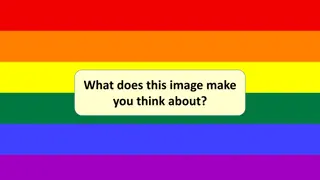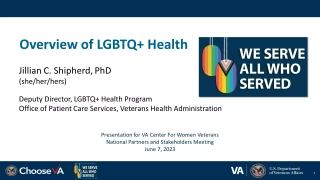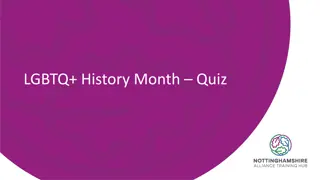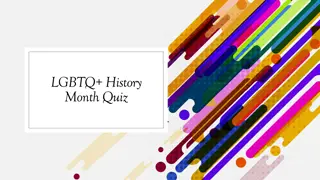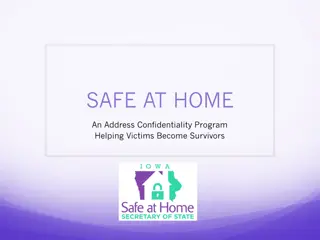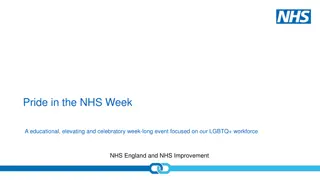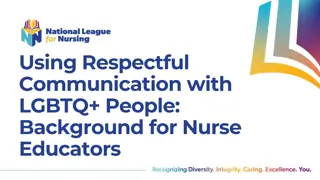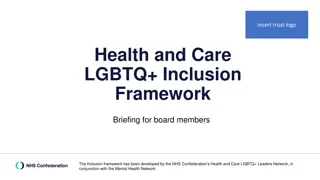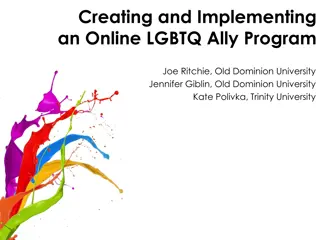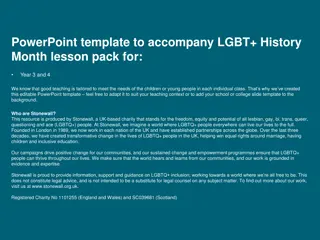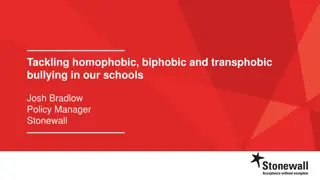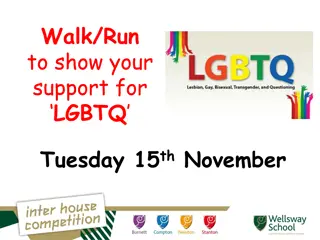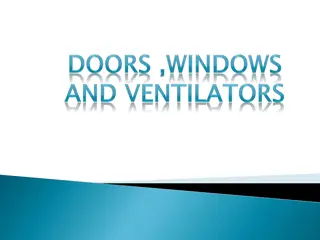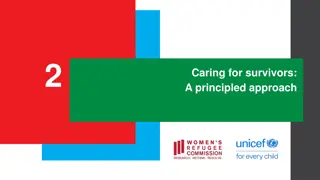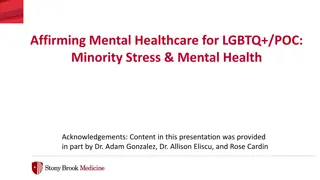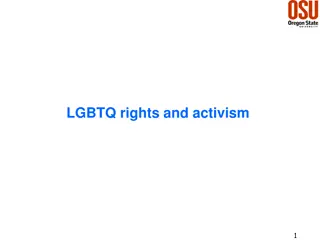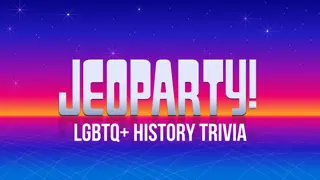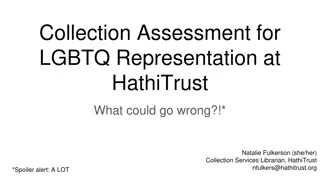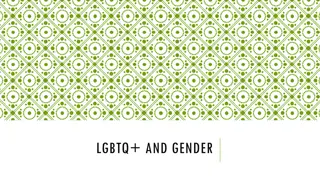Supporting LGBTQ+ Survivors with Open Hearts and Open Doors
Diverse & Resilient, a Wisconsin-based organization, aims to achieve health equity and enhance the safety of LGBTQ individuals and communities. They provide a safe space and resources for survivors, including a hotline for LGBTQ support and safety planning. The organization emphasizes understanding gender identity and expression, supporting transgender individuals and those who are gender nonconforming.
Download Presentation

Please find below an Image/Link to download the presentation.
The content on the website is provided AS IS for your information and personal use only. It may not be sold, licensed, or shared on other websites without obtaining consent from the author. Download presentation by click this link. If you encounter any issues during the download, it is possible that the publisher has removed the file from their server.
E N D
Presentation Transcript
Welcoming LGBTQ+ Survivors with Open Hearts & Open Doors in Shelter With: Kathy Flores, Kathy Flores, Diverse & Resilient Statewide LGBTQ Room to Be Safe Anti-Violence Program Manager And guests: Sharon Lewandowski Sharon Lewandowski, Department of Children & Families Courtney Olson Courtney Olson, Rainbow House Domestic Abuse Services Hosted by: End Domestic Abuse Wisconsin In Partnership with: WI Department of Children and Families
Who is Diverse & Resilient? Our mission is to achieve health equity and improve the safety and well-being of LGBTQ people and communities in Wisconsin.
What the Room to Be Safe Resource Line Provides: LGBTQ Support via Phone Safety Planning Co-Advocacy with Programs Resources Referral CONTACT INFORMATION: (414) 856-LGBT (5428) www.roomtobesafe.org
A note about language This is not an LGBTQ+ 101 For more on Lesbian, Gay, Bisexual, Transgender, Queer + identities, see previous required webinars at https://www.endabusewi.org/for- advocates/webinars/
Understanding Gender Identity and Expression (1) Gender Identity: Gender Identity: A person s internal, deeply held sense of one s own gender. Gender Expression: Gender Expression: Gender as presented through one's name, pronouns, clothing, haircut, behavior, voice, or other characteristics.
Understanding Gender Identity and Expression (2) Transgender: Transgender: A term for people whose gender identity and gender expression is different from those typically associated with their assigned sex at birth. Gender Nonconforming: Gender Nonconforming: Refers to people who do not follow other people s ideas or stereotypes about how they should look or act based on the female or male sex they were assigned at birth.
Understanding Gender Identity and Expression (3) QTPOC: QTPOC: Queer & Transgender People of Color Cisgender: Cisgender: A term for people whose gender identity and gender expression aligns with those typically associated with their assigned sex at birth.
Gender It is important to remember that we cannot figure out how someone identifies just by looking at them. We have been taught to rely on stereotypes to help us identify if someone is a part of the LGBTQ+ community. Financial Resources and Privilege for Trans and GNC Gender identity and sexual orientation are beneath the surface
Pridefest Pridefest 2019 Survey Data by Diverse & Resilient 2019 Survey Data by Diverse & Resilient From which of the following would you From which of the following would you feel most comfortable seeking services feel most comfortable seeking services for victims of intimate partner violence? for victims of intimate partner violence? 951 LGBTQ+ Survey Respondents 951 LGBTQ+ Survey Respondents 2019 Milwaukee 2019 Milwaukee Pridefest Pridefest Survey Data Survey Data LGBTQ Org Overall violence: Overall violence: Mainstream DV/SA org 79% reported experience one or more type of violence 10.00% Types of violence (people picked one or more of Types of violence (people picked one or more of the following): the following): 49% Online Harassment 34% Hate Violence 34% Sexual Violence 26% Intimate Partner Violence 27% Stalking 12% Hookup Violence 11% Financial Abuse 81.00%
Crisis for Trans Women of Color In 2019, there have already been 11 homicides of In 2019, there have already been 11 homicides of Transgender Women of Color. Transgender Women of Color. In 2017, of all the transgender people killed, 87% were In 2017, of all the transgender people killed, 87% were transgender women, 95% were Transgender Women of transgender women, 95% were Transgender Women of Color Color
In Wisconsin Lives lost to IPV Homicide: 6 (5 victims, 1 murder suicide offender) Victims were 4 gay men, 1 lesbian woman Mark Mark Batory Batory, 54 August 20, 2018 Wauwatosa IPV Ex-boyfriend , 54 Jason Jason Killps November 30, 2018 Kenosha Possible Hookup/boyfriend according to press Killps, 36 , 36 Cassandra Steward, 53 Cassandra Steward, 53 June 2, 2019 Milwaukee IPV Partner John Likeness, 54 John Likeness, 54 Dec. 30, 2018 Menomonie IPV Common Law Husband Timothy Timothy Theis January 11, 2019 West Allis IPV Ex-Boyfriend Theis, , 37
Structural Barriers for LGBTQ+ Survivors (1) Employment discrimination State laws, local protections = uneven, unequal messages Programs designed for heterosexual, cisgender women Poor screening allowing abusers to access shelter creating conflicts of interest for survivor and LGBTQ+ community.
Structural Barriers for LGBTQ+ Survivors (2) Support groups designed for heterosexual, cisgender women. Survivor having to educate providers about their identity Agencies not being public about support; not being at LGBTQ+ identified spaces.
Structural Barriers for LGBTQ+ Survivors (3) Fear of being out/outed. The myth prevails that LGBTQ relationship violence is mutual
Structural Barriers for LGBTQ+ Survivors (4) Living in a homophobic, biphobic, transphobic, and heterosexist society creates a different context for violence. Within the LGBTQ community, support may not exist.
Structural Barriers for LGBTQ+ Survivors (5) Not wanting to bring shame onto community LGBTQ communities are surprisingly small
But if we treat everyone the same, isnt that equal? One example: Police Social services, law enforcement etc. 911 Being a Number 1 Safety Tip: Homophobia, transphobia, racism and sexism and other oppression might mean this is not an option for the survivor Stonewall. A riot against police that Stonewall. A riot against police that pushed the LGBTQ movement forward. pushed the LGBTQ movement forward.
Opening our minds, hearts, & doors Assessment * LGBTQ Education * Collaboration W/LGBTQ Organizations * Personnel Policies * Create Welcoming Environment * Outreach & Media * From Network/laRed
Assessing your agency This is a more thorough look at your inclusivity within your agency. We recommend: Open Minds Open Doors workbook assessment tools: http://www.ncdsv.org/images/TheNetworkLaRed_Op enMindsOpenDoors_2010.pdf
LGBTQ Education New staff & Volunteer training Anti- Annual LGBTQ training Oppression Training On-going LGBTQ Education Annual LGBTQ Intimate Partner abuse training LGBTQ books and movies Regular screening training Adapted from Network/laRed
Collaborations with LGBTQ & Ally Orgs (1) Connection & Support Connection to LGBTQ community issues Networking & Tehnical Assistance Benefits of Collaboration Accountability Adapted from Network/laRed
Collaborations with LGBTQ & Ally Orgs (2) Collaboration Safety Adapted from Network/laRed
Policies Anti- Discrimination Survivors & Abusers Hiring Practices Personnel Policies Gender transition guidelines Family Leave Adapted from Network/laRed
Welcoming Screening for all LGBTQ imagaes and posters LGBTQ Resource Guide Creating a welcoming environment for LGBTQ survivors Anti- Accesible bathrooms Harassment Policies Gender- inclusive language LGBTQ books & resources Inclusive forms Adapted from Network/laRed
Media Responding Advertising in LGBTQ media & LGBTQ community spaces Speaking about LGBTQ survivors in public settings Attending LGBTQ events Partnering on projects Adapted from Network/laRed
Intake Affirming identity: Name Name Not legal name or preferred name Gender: Gender: ________or________ Pronouns Pronouns: Example: My name is Kathy and I use She/Her/Hers pronouns Not preferred pronouns
How to be welcoming through your words Use the term Survivors rather than women when referring to people you serve. Use a variety of pronouns. Use the term partner or abusive partner rather than man, boyfriend, batterer, etc. Use a variety of pronouns. Adapted from Shelter Access Toolkit by The Network
How to be welcoming through your space (1) Provide a variety of support groups that include all communities. Create residential rooms that can be connected or separated. Use your existing space creatively so LGBTQ+ people are not excluded. Provide gender inclusive bathrooms Adapted from Shelter Access Toolkit by The Network
How to be welcoming through your space (2) Consider ways you can communicate with residents that you are inclusive, beginning at intake. Discuss non- discrimination policy with all new residents. If residents say or do something homophobic, transphobic or racist, address the issue address the issue. Adapted from Shelter Access Toolkit by The Network
Assessment on Predominant Aggressor Power & Control assessment Physical: Assess the impact. Is this self-defense? Who has injuries? Emotional: Whose world is getting smaller? Who is feeling more isolated? Who feels more responsible/guilty? Economic Violence: Who has control of finances? Are they used as power and control? Sexual: Who controls decisions around sex? Does one feel coerced? Does one have sex with partner in order to avoid conflict? Adapted from Shelter Access Toolkit by The Network
Do not ask why. Ask what, who, how, where, when Context Context: Is the coercive or aggressive behavior about trying to survive or about trying to control? Effect Effect: How did the behavior affect the person you are talking to? Intent Intent: It isn t about figuring out who did what to whom, it is about determining which person is exercising systemic power and control over the other Adapted from Shelter Access Toolkit by The Network
General Screening Questions (1) Get a general sense of the relationship and what brought the person to us for support. These questions can help build trust and alliance with the survivor: 1. Could you tell me about your relationship? 2. Did something in particular happen that made you come to/contact us now? 3. What is/are your concerns? In partnership with avp.org
General Screening Questions (2) Have either you or your ex-partner/s used our services before? Not a screen out question, but the answers here are telling. Let s discuss: Are they defensive? Do they say yes, my ex went there once, but they are crazy and off their meds and lied about me abusing them In partnership with avp.org
Getting more specific Ask for examples: Would you mind sharing with me examples of _____? We are looking for patterns in the behavior. How often do you feel this happens? In partnership with avp.org
Entitlement (based on race, education, economic justice, citizenship, etc.) Are you able to be fully yourself with this person (gender and sexuality)? Are you able to work? Is your ex/partner able to work? Are you out about your gender identity and/or sexual orientation at work? How is immigration status or race spoken about or used in the relationship? In partnership with avp.org
Isolation I can contact friends and family I can contact friends, family, service providers, employers, etc. Friends and family visit me I feel isolated or lonely In partnership with avp.org
Agency (ability to make decisions for oneself) What led you to reach out for support? Do you feel able to do things without your ex/partner? Do you feel like you have control over your life decisions? Do you feel able to visit friends or family? (planned or unplanned visits) Do you feel able to make financial decisions? Who makes the financial decisions? In partnership with avp.org
Effects/Consequences (of behavior) Is there a time when you feel your ex/partner s behavior changed (and it feels unsafe or uncomfortable)? How many times a day does your ex/partner check in? Does it affect your day? What does it feel like when you or your partner/ex- partner gets angry? Do you feel like your ability to decide what you want/want to do/options is/are getting bigger or smaller? In partnership with avp.org
Fear/Dread (of being hurt or hurting someone else) Have you ever been or are you afraid of your ex/partner? If so: When was the first time you felt afraid? When was the last time you felt this way? Do you feel safe when your ex/partner is in your home/at home? If no : Is there anywhere that you do feel safe? Is there any other place that you feel unsafe? In partnership with avp.org
Fear/Dread (2) (of being hurt or hurting someone else) Have you ever felt or do you feel unsafe/uncomfortable/uneasy in your relationship? If so: When was the first time you felt unsafe/uncomfortable/uneasy When was the last time you felt this way? In partnership with avp.org
Use of Violence How would you define violence? Have you experienced violence in your relationship? If so: What was the most recent incident of violence? What was the worst incident of violence? In partnership with avp.org
Use of Violence (2) Have you felt the need to be violent? If so, what happened? Has your ex/partner ever forced you to have sex or engaged in unwanted sexual behavior? In partnership with avp.org
Interview with Courtney Olson Rainbow House-Marinette
Resources for LGBTQ Survivors Diverse & Resilient statewide Room to Be Safe AVP: www.roomtobesafe.org Diverse & Resilient main page: www.diverseandresilient.org Rainbow House, Marinette: https://therainbowhouse.us/ NCAVP: www.avp.org/ncavp The Network/La Red: www.tnlr.org The Northwest Network: www.nwnetwork.org
Resources for inclusive gender images The Gender Spectrum Collection: Stock Photos Beyond the The Gender Spectrum Collection: Stock Photos Beyond the Binary Binary The Gender Spectrum Collection is a stock photo library featuring images of trans and non-binary models that go beyond the clich s. This collection aims to help media better represent members of these communities as people not necessarily defined by their gender identities people with careers, relationships, talents, passions, and home lives. Make sure you read the guidelines and this is not for commercial use. https://broadlygenderphotos.vice.com/
Books and publications Film: Bruising for Besos (now available on Amazon) Surviving With Wild Tongues Sobreviviendo Con Lenguas Indomables (YOUTUBE) Publication: Survived and Punished: Survivor Defense as Abolitionist Praxis (PDF at https://survivedandpunished.org/ ) Queering Sexual Violence: Radical Voices from Within the Anti-Violence Movement by Jennifer Patterson For many publication recommendates: The Clearinghouse for LGBTQ publications at Northwest Network https://www.nwnetwork.org/clearinghouse
K Kathy Flores athy Flores Diverse & Resilient LGBTQ Statewide Program Manager Intimate Partner Violence kflores@diverseandresilient.org www.roomtobesafe.org
Circle saying "Take survey" Feedback Survey Click on the Take Survey circle to let us know how we did, what more you want to know, and anything else that would be helpful to share. Survey available at: https://www.surveymonkey.co m/r/LGBTQ2019feedback Facebook logo Twitter logo Social Social Media Media @end.domestic.abuse.wi @endabuseWI


